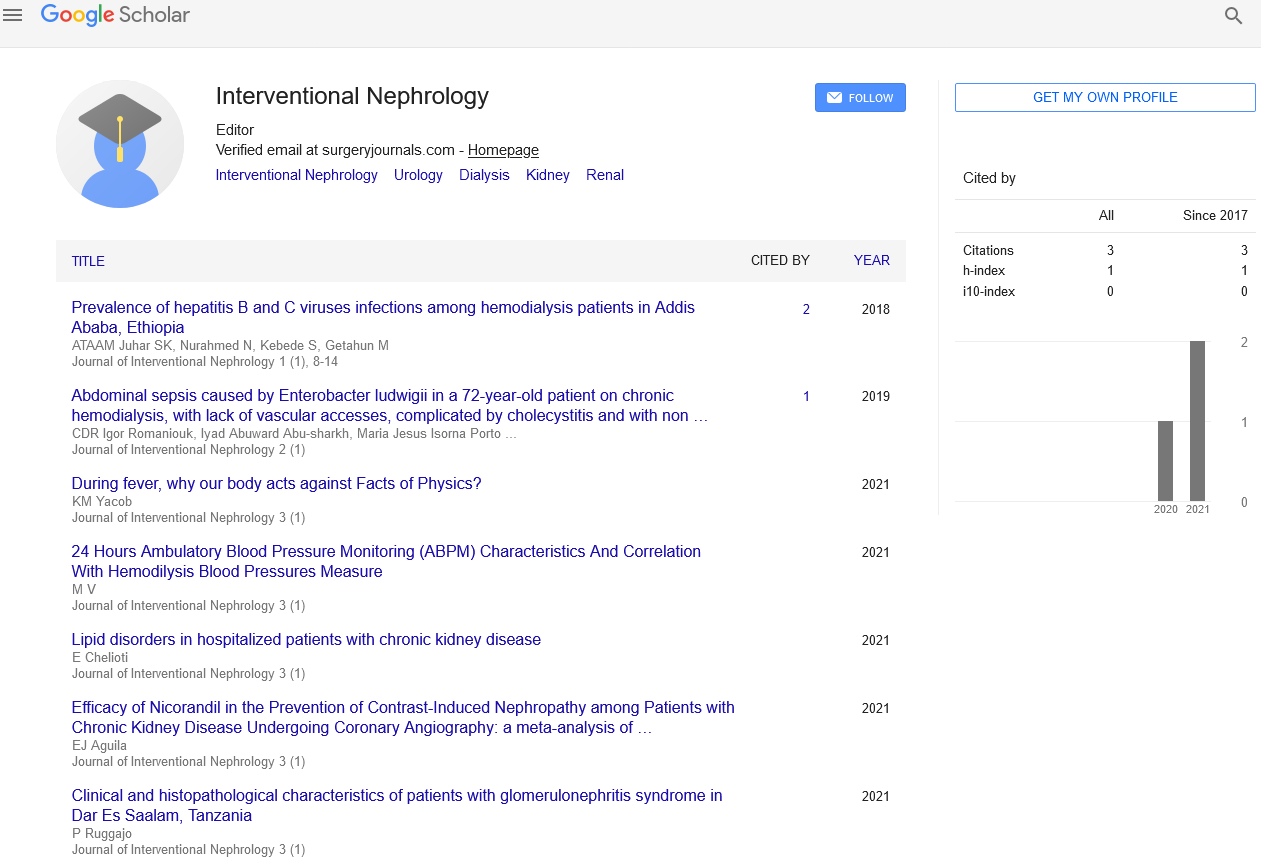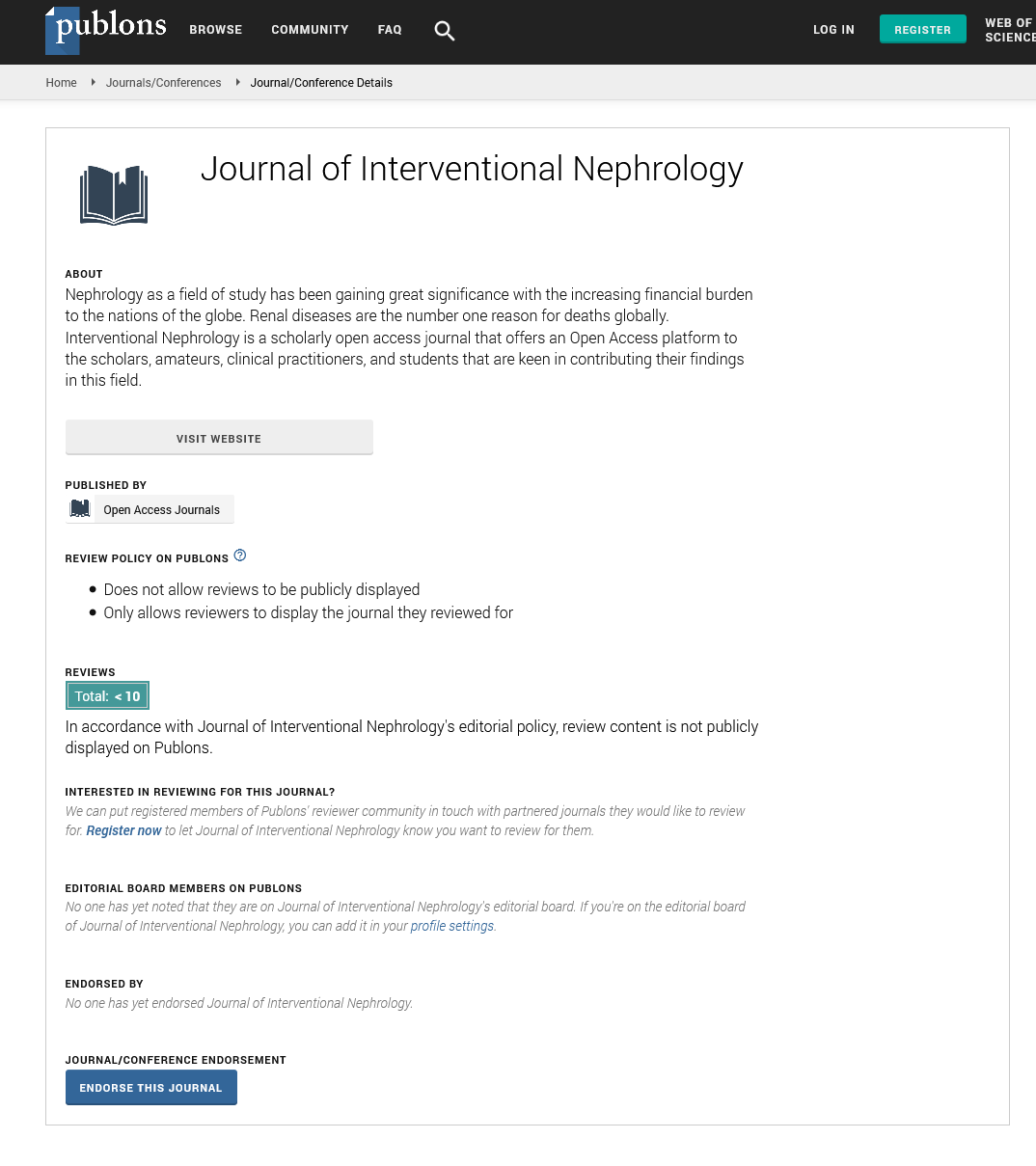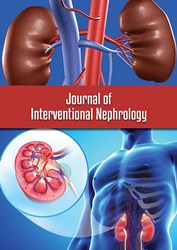Perspective - Journal of Interventional Nephrology (2024) Volume 7, Issue 4
The Role of Multidisciplinary Teams in Nephrology Interventions: Enhancing Patient Care through Collaborative Approaches
- Corresponding Author:
- Mingli Yuan
Department of Nephrology, Drexel University, Egypt
E-mail: YuanMingli1700@es.edu
Received: 29-Jul-2024, Manuscript No. OAIN-24-143630; Editor assigned: 31-Jul-2024, PreQC No. OAIN-24-143630 (PQ); Reviewed: 13-Aug-2024, QC No. OAIN-24-143630; Revised: 20-Aug-2024, Manuscript No. OAIN-24-143630 (R); Published: 30-Aug-2024, DOI: 10.47532/oain.2024.7(4).295-297
Introduction
Nephrology interventions often require complex decision-making and a multifaceted approach to patient management. The intricate nature of kidney diseases and the diverse array of treatment options necessitate collaboration among healthcare professionals with varied expertise. Multidisciplinary Teams (MDTs) have emerged as a crucial component in the management of nephrological conditions, offering a holistic approach to patient care. This article explores the role of multidisciplinary teams in nephrology interventions, highlighting their benefits, key components, and strategies for effective collaboration.
Description
The concept of multidisciplinary teams
Definition and structure
Multidisciplinary teams: MDTs consist of professionals from different specialties working together towards a common goal: Optimizing patient outcomes. In nephrology, this team typically includes nephrologists, interventional nephrologists, surgeons, radiologists, nurses, dietitians, social workers, and other specialists as needed.
Team dynamics: Effective MDTs operate through structured communication, regular meetings, and shared decision-making. The team’s composition and structure may vary based on the complexity of the case and the specific needs of the patient.
Advantages of multidisciplinary approaches
Comprehensive care: MDTs provide a holistic approach to patient care by integrating diverse perspectives and expertise. This comprehensive approach ensures that all aspects of a patient’s condition are addressed, from diagnosis and treatment to rehabilitation and long-term management.
Improved patient outcomes: Studies have shown that MDTs can lead to improved clinical outcomes, including better management of chronic conditions, reduced hospitalizations, and enhanced quality of life. The collaborative nature of MDTs promotes thorough evaluation and personalized treatment plans.
Key components of multidisciplinary teams in nephrology
Nephrologists
Role: Nephrologists are central to the management of kidney diseases. They diagnose and treat a wide range of conditions, including Chronic Kidney Disease (CKD), Acute Kidney Injury (AKI), and glomerular disorders. They also oversee the coordination of care provided by other team members.
Responsibilities: Nephrologists evaluate patient symptoms, order diagnostic tests, and develop treatment plans. They work closely with other specialists to ensure that interventions align with the overall care strategy.
Interventional nephrologists
Role: Interventional nephrologists perform minimally invasive procedures essential for the management of kidney diseases. This includes procedures such as dialysis access creation, renal biopsies, and endovenous laser therapy.
Responsibilities: They collaborate with nephrologists and other team members to plan and execute procedures, address complications, and monitor patient outcomes. Their expertise is crucial for ensuring the effectiveness and safety of interventional treatments.
Surgeons
Role: Surgeons, including vascular surgeons and transplant surgeons, play a critical role in the management of patients requiring surgical interventions. This may involve kidney transplantation, creation of Arteriovenous Fistulas (AVFs), or other surgical procedures.
Responsibilities: Surgeons work closely with nephrologists and interventional nephrologists to coordinate surgical timing, assess surgical risks, and ensure postoperative care. Their expertise is vital for optimizing surgical outcomes and managing complications.
Radiologists
Role: Radiologists provide essential imaging support, including ultrasound, Computed Tomography (CT), and Magnetic Resonance Imaging (MRI). These imaging modalities are crucial for diagnosing kidney conditions and guiding interventional procedures.
Responsibilities: Radiologists interpret imaging results, assist in procedural planning, and monitor treatment progress. Their input helps ensure accurate diagnoses and effective interventions.
Nurses
Role: Nurses are integral to patient care, providing support throughout the treatment process. They are involved in monitoring patient conditions, administering medications, and educating patients about their care.
Responsibilities: Nurses collaborate with the MDT to manage patient symptoms, provide emotional support, and ensure adherence to treatment plans. Their role is essential for maintaining continuity of care and addressing patient concerns.
Dietitians
Role: Dietitians specialize in nutritional management, which is crucial for patients with kidney disease. They develop personalized dietary plans to address specific needs related to kidney function and overall health.
Responsibilities: Dietitians work with the MDT to assess nutritional status, provide dietary recommendations, and educate patients about managing their diet. Proper nutrition is essential for managing CKD and other kidney-related conditions.
Social workers
Role: Social workers provide psychosocial support, helping patients navigate the emotional and practical challenges of managing chronic kidney disease. They assist with issues such as coping with illness, accessing community resources, and coordinating care.
Responsibilities: Social workers collaborate with the MDT to address patient and family concerns, facilitate communication, and support patients in managing the social aspects of their care.
Strategies for effective multidisciplinary collaboration
Structured communication
Regular meetings: Scheduling regular MDT meetings ensures that all team members are updated on patient progress and can contribute to care planning. These meetings foster collaborative decision-making and enhance team cohesion.
Clear documentation: Maintaining clear and comprehensive documentation of patient care plans, treatment decisions, and interdisciplinary interactions is crucial for ensuring continuity and consistency in care.
Defined roles and responsibilities
Role clarity: Clearly defining the roles and responsibilities of each team member helps avoid duplication of efforts and ensures that all aspects of patient care are addressed. This clarity also promotes accountability and efficient use of resources.
Coordination of care: Effective coordination between team members, including timely communication and shared decision-making, is essential for managing complex cases and ensuring that interventions are well-integrated.
Patient and family involvement
Patient engagement: Engaging patients and their families in the care process enhances their understanding of treatment options and empowers them to actively participate in decisionmaking. This involvement is a key aspect of patient-centered care.
Feedback mechanisms: Providing opportunities for patients and families to give feedback on their care experience helps identify areas for improvement and ensures that care plans are aligned with patient preferences and needs.
Case studies: Success stories of MDTs in nephrology
Kidney transplant programs
Integrated care: In advanced kidney transplant programs, MDTs comprising nephrologists, transplant surgeons, radiologists, and social workers work together to provide comprehensive care. This collaborative approach enhances pretransplant evaluations, surgical outcomes, and post-transplant management, leading to improved patient survival and quality of life.
Dialysis access management
Optimized procedures: MDTs involved in dialysis access management, including interventional nephrologists, vascular surgeons, and nurses, collaborate to create and maintain effective dialysis access. This integrated approach reduces complications, improves access longevity, and enhances patient satisfaction.
Conclusion
The role of multidisciplinary teams in nephrology interventions is pivotal in delivering high-quality, patient-centered care. By bringing together diverse expertise and perspectives, MDTs provide a comprehensive approach to managing kidney diseases, improving clinical outcomes, and enhancing patient experiences. Effective communication, defined roles, and patient engagement are key components of successful multidisciplinary collaboration.
As nephrology continues to evolve, fostering a collaborative environment and leveraging the strengths of multidisciplinary teams will be essential for advancing care and addressing the complex needs of patients with kidney conditions. Embracing these principles will ultimately lead to more effective, holistic, and compassionate care, reflecting the core values of modern nephrology practice.


